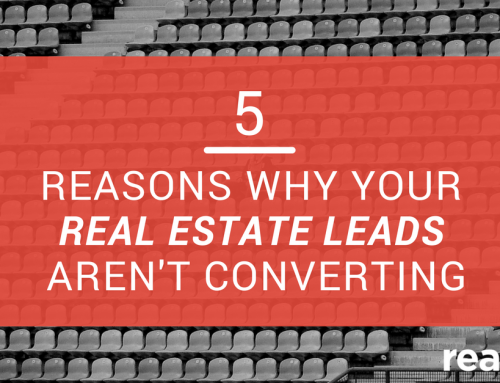Having trouble converting your online real estate leads regardless of the time of season?
Let’s start by getting one thing out in the open—the problem isn’t the leads. The problem is how you’re handling the leads. To paraphrase Alec Baldwin in Glengarry Glen Ross, the leads aren’t weak—you’re weak.
More specifically, your follow-up is weak.
Read on to learn why online lead follow-up is so challenging and how you can develop messaging that will break the ice.
The Cold, Hard Truth About Online Leads
Web leads are tough. These people don’t know you—you’re just a name and a grinning headshot on some website. They certainly don’t trust you—not yet, anyways. And you don’t know much about them, either. You don’t know where they are in the buyer/seller journey, how many other agents they’ve already spoken to, or how knowledgeable they are on the buying/selling process.
They’re cold leads.
Most likely, your initial interaction with them is not going to convert them into a client. It’s going to be a gradual process.
Here’s the truth: 100% purchased leads (cold leads) aren’t going to have the same conversion rate as 100% owned leads (people already in your database). The average industry-wide web lead conversion rate (lead to closings) is 0.5-1%. For this reason, the majority of our focus should be on repeat/referral business.
Related article: The Truth About Buying Online Real Estate Leads
With that being said, buying web leads is a great supplemental strategy to use in addition to your other, more lucrative strategies.
But how do you convert those leads into clients? To answer that question, let’s turn to one of my favorite topics: social psychology.
The Psychology of Lead Follow-Up
Real estate agent, coach, and author Krista Mashore has great advice for a process for handling your new and existing contacts that emphasizes the psychology of lead follow-up:
In social psychology, there is something called the stereotype content model, which hypothesizes that people form first impressions of others based on two factors: warmth and competence. According to Harvard Business School professor Amy Cuddy and her colleagues, we answer two questions every time we meet someone new:
- Can I trust this person?
- Can I respect this person?
In Cuddy’s recently released book, Presence, she offers a new piece of advice: warmth (trustworthiness) is the more important factor.
When it comes to converting your online leads, focus on warmth first, competence second. Earn their trust first, then show them what you can do.
So, how do you inject more warmth into your follow-up?
6 Ways To Be Warmer In Your Follow-Up
1) Focus on the person, not the transaction.
That initial phone conversation should be all about getting to know your lead. Ask questions. Learn her story. Find out why she’s moving and what kind of lifestyle she wants, in addition to what she’s looking for in a home. Show interest in her, not in the potential transaction.
2) Send a video email.
Picture this: your lead clicks to open your email…and he’s greeted not by paragraphs of text, but by a video of you talking directly to him! This adds a much-needed dose of warmth to your follow-up emails. BombBomb, my video email service of choice, reported that salespeople who started using video in their email saw an 81% increase in replies, 87% increase in clicks, and a 60% increase in converting leads. Pretty solid!
3) Repeat a mantra to maintain a positive mindset.
It’s easy to lose your cool when you’re dealing with different types of people all day. But your attitude will be reflected in your communications with leads, so it’s important to stay positive. Feel free to use my mantra to get into the right state of mind:
“I approach every call with passion and purpose, and I am warm before I am smart.”
4) Write conversationally.
In an article for Copyblogger, business writing coach Henneke Duistermaat suggests imagining that you are sitting down to have coffee with a friend. Write the way you would talk. If you say things like “kinda” and “Wowzers!” in everyday conversation, use those words in your emails. You’ll sound like a real person rather than a generic email template. Other tips:
- Write short sentences. Even really short, choppy sentences. Like this.
- Break a few grammar rules. Try starting a sentence with “And” or “But.”
- Use a one-sentence paragraph to really drive home a point.
5) Empathize.
Put yourself in their shoes. It’s common for buyers and sellers to feel anxious, excited, overwhelmed, optimistic, and discouraged. Acknowledge these emotions in your emails and initial conversations. Depending on the situation, you might say, “I know all of this information feels a little overwhelming…” or “What an exciting time for you two!”
6) Share your story (briefly).
Obviously, you don’t want to go on and on about yourself. But offering up a little about yourself—particularly in that very first email or conversation—can help to create a connection between you and your lead. And I don’t mean you should tell them about all of the happy clients you’ve helped close on homes. (“If you only discuss your topic of expertise,” Duistermaat says, “you show yourself as a one-dimensional expert. It’s kind of boring.”) I mean you should tell them about your Why—your purpose, or the reason why you are in this business. Maybe something like this:
“I remember exactly how I felt the day we closed on our first home. I felt so proud, and so excited for the new chapter in our lives. I’m really looking forward to helping you get to that point, too.”
The success of your online lead generation strategy depends on how well you follow up. And great follow-up has many components—your response time (5 minutes or less), the tools you use (workflows and templates), and, of course, your messaging.
When you’re crafting your emails, text messages, and phone scripts, make sure they are warm before they are smart. That’s how you’ll start the long process of building trust and converting your leads to clients.





